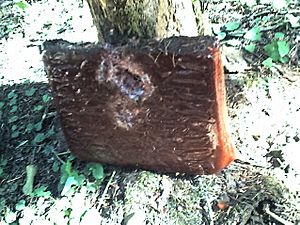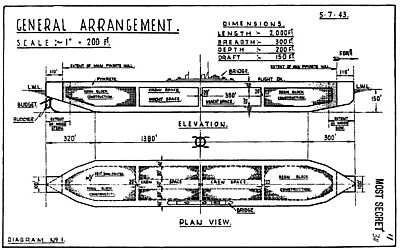Project Habakkuk facts for kids
Project Habakkuk was a secret plan by the British during World War II to build a giant aircraft carrier. This huge ship was meant to be made from a special material called pykrete. Pykrete is a mix of wood pulp (like tiny wood fibers) and ice.
The idea was to use this ice carrier in the middle of the Atlantic Ocean. At that time, German U-boats (submarines) were sinking many supply ships, and regular planes couldn't fly far enough from land to protect them.
The idea for Project Habakkuk came from a clever inventor named Geoffrey Pyke. After some promising tests and even building a small model in Canada, the project was stopped. It became too expensive, and new planes with longer ranges and smaller escort carriers helped solve the problem of U-boats in the Atlantic.
Contents
History
The Big Idea
Geoffrey Pyke worked for a special British military group called Combined Operations Headquarters. He was seen as a genius by his boss, Lord Mountbatten.
Pyke thought of Habakkuk while he was in the United States. He was trying to figure out how to protect ships crossing the Atlantic, especially when they were too far from land for planes to cover them. The problem was that steel and aluminum were hard to get because they were needed for other war efforts.
Pyke had a different idea: ice! He realized that ice could be made using much less energy than steel. He suggested building a huge floating island, either natural or artificial, that could have a flat runway for planes and even shelters inside for aircraft.
He sent his idea to Lord Mountbatten, who then shared it with Prime Minister Winston Churchill. Churchill was very excited about the plan.
Pyke wasn't the first to think of a floating ice island for planes. A German scientist had suggested it in 1930. The idea came up again in 1940 in the British Admiralty, but many officers thought it was a joke.
The Secret Name
The project's code name was "Habakkuk." Sometimes, it was accidentally spelled "Habbakuk" in official papers. The name comes from a Bible verse that talks about something so amazing, people won't believe it even when they're told: "Behold ye among the heathen, and regard, and wonder marvellously: for I will work a work in your days, which ye will not believe, though it be told you."
What is Pykrete?
In early 1942, Pyke and another scientist, J.D. Bernal, asked Max Perutz to figure out if a huge ice floe could be built quickly enough to handle the rough Atlantic Ocean. Perutz found that natural icebergs weren't good because they didn't have enough flat surface for a runway and could suddenly flip over.
The project might have been given up if it weren't for the invention of pykrete. This new material was a mix of water and wood pulp. When frozen, pykrete was much stronger than regular ice. It also melted much slower and would not sink in water.
Pykrete could be shaped like wood and molded like metal. When it was in water, a layer of wet wood pulp would form on its surface, protecting the inside from melting further. However, Perutz discovered a problem: ice slowly changes shape under pressure, a process called "plastic flow." His tests showed that a pykrete ship would slowly sag unless it was kept very cold, around -16°C (3°F). This meant the ship would need good insulation, a huge refrigeration system, and many cooling ducts.
Perutz did his experiments on pykrete in a secret location under the Smithfield Meat Market in London. He worked in a refrigerated meat locker, hidden behind frozen animal carcasses!
Building a Model
It was decided to build a large model of the ship in Jasper National Park in Canada. This model would help scientists study how to insulate the ship, how to keep it cold, and how pykrete would hold up against attacks.
Large blocks of ice were made at Lake Louise, and a smaller prototype was built at Patricia Lake, Alberta. This model was 18 meters (60 feet) long and 9 meters (30 feet) wide, weighed 1,000 tons, and was kept frozen by a small one-horsepower motor. The work was done by conscientious objectors (people who refused military service for moral or religious reasons) who helped with other jobs instead. They were never told what they were building.
The Canadians were confident they could build a full-sized ship by 1944. They had plenty of wood pulp, insulation, timber, and steel. The estimated cost was about £700,000.
Meanwhile, Perutz found that the best pykrete mix was 14% wood pulp and 86% water. But by May 1943, the problem of the ice slowly changing shape became serious. It was clear that the ship would need more steel inside and a better insulating skin on the outside. This made the estimated cost jump to £2.5 million. Also, the Canadians decided it was too hard to build the ship for 1944.
Geoffrey Pyke was later left out of the planning to encourage American involvement, partly because he had argued with American officials before.
Naval architects and engineers kept working on Habakkuk. The requirements for the ship grew bigger: it needed to travel 7,000 miles (11,265 km), survive the biggest waves, and be torpedo-proof, meaning its walls had to be at least 12 meters (40 feet) thick. The Fleet Air Arm (the Royal Navy's air force) wanted heavy bombers to take off from it, so the deck needed to be 610 meters (2,000 feet) long. Steering was also a problem; a rudder over 30 meters (100 feet) high was needed, but they never figured out how to control it.
Different Designs
Naval architects came up with three different versions of Pyke's original idea:
- Habakkuk I: This version would have been made of wood, but it was quickly dropped.
- Habakkuk II: This was the closest to the original idea. It would have been a very large, slow ship made of pykrete with steel inside. It was planned to be 1,200 meters (3,937 feet) long and 180 meters (590 feet) wide.
- Habakkuk III: This was a smaller, faster version of Habakkuk II.
The final design for Habakkuk II, sometimes called the "bergship," would have weighed 2.2 million tons. It would have had steam generators powering 26 electric motors placed outside the ship (regular ship engines would make too much heat for an ice craft). It was planned to have 40 large anti-aircraft guns and many smaller ones. It would have a runway and could hold up to 150 twin-engined bombers or fighters.
Why the Project Ended
By the time of the 1943 Quebec Conference, Project Habakkuk had the support of both Churchill and Mountbatten. It was given to the National Research Council of Canada because of Canada's cold winters and their experience with ice.
The small prototype built in 1944 at Patricia Lake showed that a full-sized ship would cost more money and resources than a whole fleet of regular aircraft carriers. Lord Mountbatten later listed several reasons why the project was stopped:
- There wasn't enough steel for other important war needs.
- Portugal allowed the Allies to use airfields in the Azores, which helped hunt U-boats in the Atlantic.
- New long-range fuel tanks allowed British planes to patrol the Atlantic for longer.
- More escort carriers (smaller aircraft carriers) were being built.
Mountbatten himself also stepped away from the project.
The last meeting about Habakkuk happened in December 1943. It was officially decided that the "large Habbakuk II made of pykrete has been found to be impractical because of the enormous production resources required and technical difficulties involved."
The idea of using ice was already becoming less popular. Other ideas for "floating islands" were considered, like welding Liberty Ships together. It took three hot summers for the prototype built in Canada to completely melt away.
Max Perutz later said that the United States Navy decided Habakkuk was not practical. One reason was that the huge amount of steel needed for the refrigeration system to freeze the pykrete was more than the steel needed to build an entire carrier out of steel. But the main reason was that land-based planes were getting better and could fly much farther, making floating islands unnecessary.
Modern Experiments
In an episode of the U.S. TV show MythBusters in 2009, hosts Jamie Hyneman and Adam Savage built a small boat out of a modified pykrete. They used whole sheets of wet newspaper instead of wood pulp. They successfully sailed the boat in Alaskan waters at 25 mph (40 km/h). However, it started leaking after 20 minutes. They tried to fix the leaks and pump out water, but after 10 more minutes, they had to head back to shore. They concluded that it is possible to build a boat from pykrete, and it was strong and melted slowly, but they doubted a pykrete aircraft carrier could have lasted long. Their conclusion was "Plausible, but ludicrous."
In September 2010, the BBC show Bang Goes The Theory also tried to build a pykrete boat. They made a hull using 5,000 kg (11,023 lbs) of hemp fiber pykrete and froze it. They launched it in Portsmouth Harbour for a trip across The Solent. The boat immediately started leaking because of holes cut for an outboard motor, and the motor's weight pulled these holes below the water.
See also
 In Spanish: Proyecto Habakkuk para niños
In Spanish: Proyecto Habakkuk para niños





